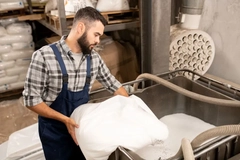Scientists develop bio-based foam packs for cold-chain food transport

Researchers in Finland and Spain have developed a bio-based packaging solution for cold-chain food transport amid consumer demand for sustainable and functional food packaging that offers thermal regulation and antibacterial protection.
The bio-based foams were created by combining polyethylene glycol (PEG) with a cellulose structure and pomegranate peel (PMP) powder.
After testing, the product achieved stable thermal regulation and integrated antibacterial and antioxidants for enhanced product safety.
Moreover, a LCA determined that the bio-based foam reduced carbon footprint by 25% compared to conventional petroleum-based alternatives.
The assessment estimated the cradle-to-grave environmental impact of bio-based foams. The study was conducted along ISO 14040/44 standards, and the results evaluated processes related to raw material acquisition, energy consumption for on-site production, and waste management.
Published in Sustainable Materials and Technologies, the study concludes that multifunctional packaging foams can meet the technical requirements needed for temperature-sensitive food, displacing the need for fossil-based polystyrene, polyurethane, or vacuum-insulated panels.
Achieving thermal regulation
Maintaining the optimal temperature during storage and transportation is essential in food packaging. Even slight temperature fluctuations can adversely affect food quality, shelf life, and safety. To tackle this issue, phase change materials (PCMs) are often used as an effective solution for temperature regulation.
PCMs work by absorbing, storing, and releasing thermal energy. In cold-food packaging, when the room temperature rises above the melting point of the PCM, it absorbs heat, preventing the surrounding environment from warming up. When the temperature drops, PCMs solidify, releasing stored heat and stabilizing the temperature.
 The foams were created using pomegranate peel and cellulose.The most common type of PCM is hydrated salts, which are known for their thermal properties and cost-effectiveness. However, they also have high supercooling, unstable shape, and phase separation.
The foams were created using pomegranate peel and cellulose.The most common type of PCM is hydrated salts, which are known for their thermal properties and cost-effectiveness. However, they also have high supercooling, unstable shape, and phase separation.
According to the study, PEG is an alternative PCM that has a suitable phase transition, is non-toxic, and is compatible with bio-based materials. However, PEG can leak during phase change, limiting the effectiveness of temperature regulation and packaging material integrity.
Bio-based protection
The study stabilized PEG by combining it with a cellulose-based matrix that encapsulates it. This forms chemical interactions, like hydrogen bonding, which can reinforce the structural integrity of the composite, preventing leakage while maintaining PEG thermal properties.
Another challenge related to cold-chain food transport is potential microbial growth. The researchers addressed this by using active packaging “that extends beyond passive containment by actively interacting with the product to preserve its quality (for example, through moisture control or antimicrobial action).”
For the study, the research team implemented materials that prevent bacterial growth, enhance shelf life, and reduce contamination. They also note: “As the demand for sustainable and biodegradable packaging materials grows, there is increasing interest in replacing synthetic additives with natural, plant-based alternatives.”
To meet this demand, the researchers combined the cellulose-PEG composite with PMP powder. PMP boasts many antimicrobial compounds and has proven efficacy against a wide range of bacteria.
The research resulted in an eco-friendly, biodegradable material that offers antibacterial protection and thermal regulation — a multifaceted solution for the food packaging industry.










